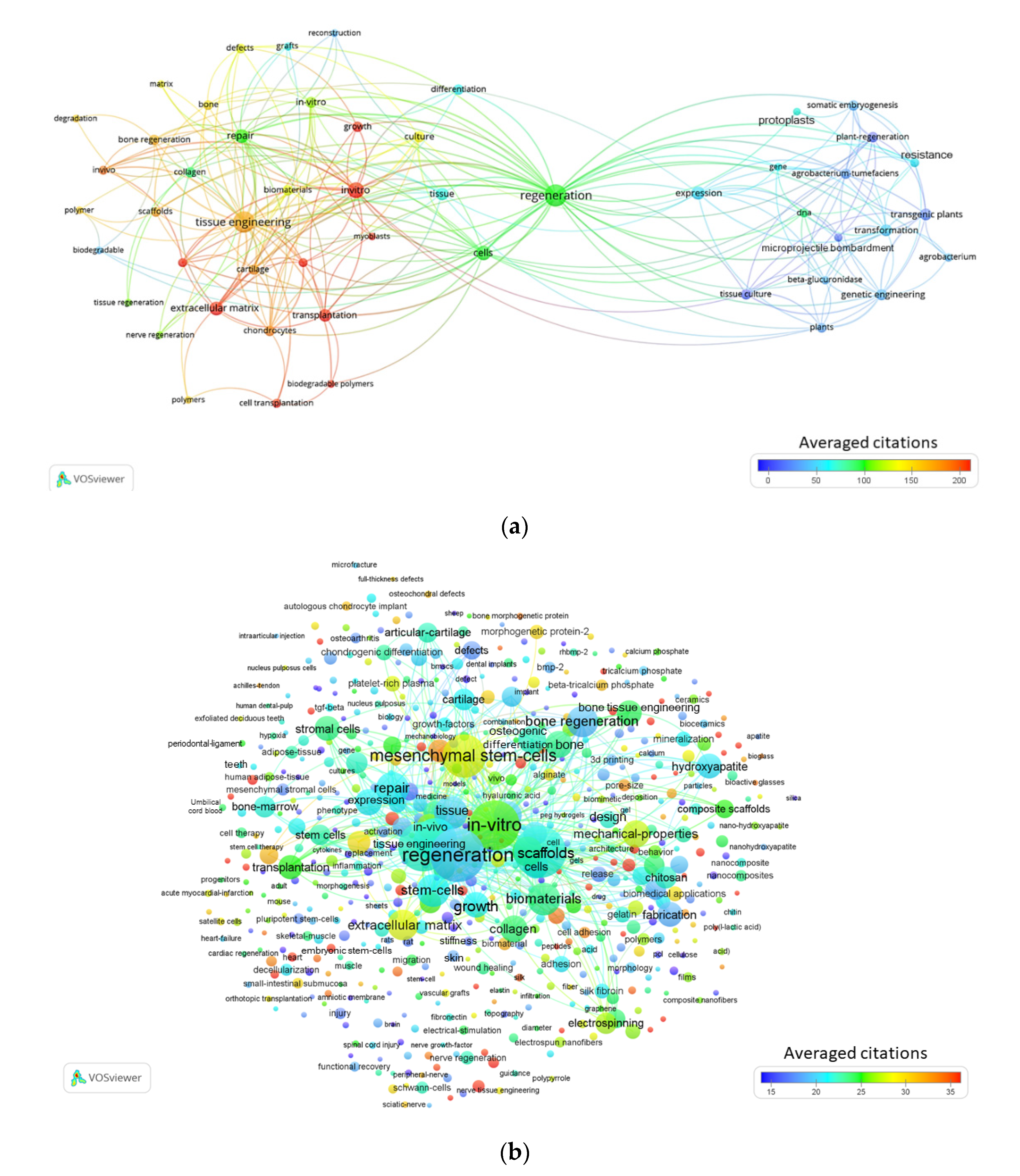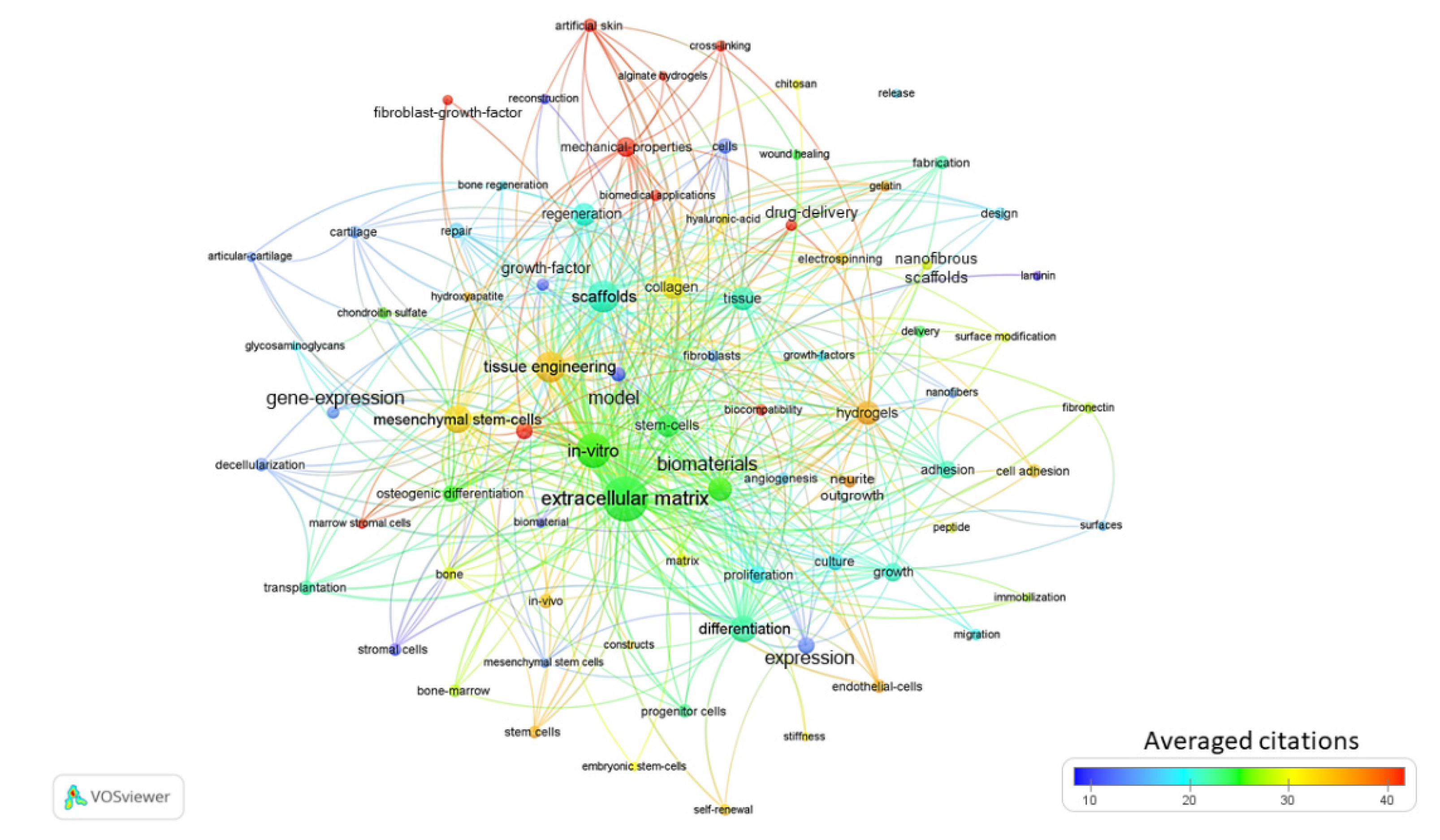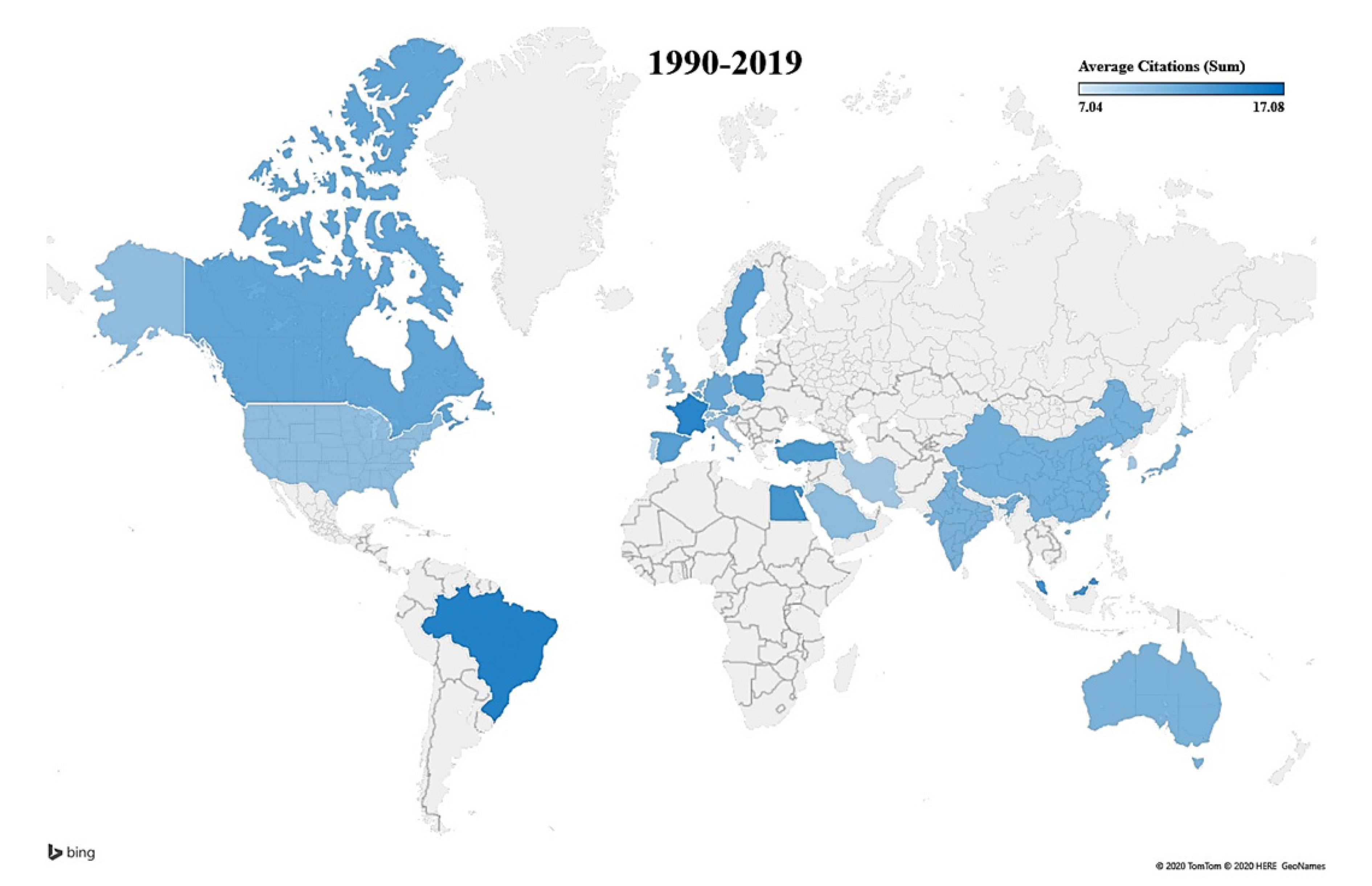A Bibliometric Review of Artificial Extracellular Matrices Based on Tissue Engineering Technology Literature: 1990 through 2019
Abstract
1. Introduction
2. Materials and Methods
2.1. Data Source and Search Strategy
- (1)
- Topic set 1 = (tissue engineer and regeneration);
- (2)
- Topic set 2 = (biomaterial and regeneration);
- (3)
- Topic set 3 = (artificial extracellular matrix) and (stem cell or axon or neural regeneration or central nervous system or regeneration or tissue engineer or biomaterial).
2.2. Data Analyses and Presentation
3. Results
3.1. Publication Output: Topic Set 1, 2 and 3 for 1990–2019
3.2. Evolution of Bibliographic Terms: Topic set 1 for the 1990s and 2010s
3.3. Evolution of Bibliographic Terms: Topic Set 3 for the 2010s
3.4. Evolution of Bibliographic Terms in Relation to Countries of Origin: Topic Set 1
3.5. Evolution of Bibliographic Terms in Relation to Countries of Origin: Topic Set 2
3.6. Evolution of Bibliographic Terms in Relation to Countries of Origin: Topic Set 3
3.7. Profile of the Top 10 Most Productive and the Most Cited Authors: Topic Set 1 for 1990 through 2019
3.8. Profile of the Top 10 Productive and the Most Cited Organizations: Topic Set 1 for 1990 through 2019
4. Discussion
5. Conclusions
Supplementary Materials
Author Contributions
Funding
Conflicts of Interest
Abbreviations
| aECM | Artificial Extracellular Matrix |
| ECM | Extra cellular matrix |
| TE | Tissue engineering |
| RM | Regenerative medicine |
| ts | Topic search |
| SCI | Spinal cord industry |
| MIT | Massachusetts Institute of Technology |
References
- Naveau, A.; Smirani, R.; Catros, S.; De Oliveira, H.; Fricain, J.-C.; Devillard, R. A Bibliometric Study to Assess Bioprinting Evolution. Appl. Sci. 2017, 7, 1331. [Google Scholar] [CrossRef]
- Park, J.; Lakes, R.S. Biomaterials: An Introduction, 3rd ed.; Springer: Berlin, Germany, 2007; pp. 1–561. [Google Scholar]
- Keane, T.; Badylak, S. Biomaterials for tissue engineering applications. Semin. Pediatric Surg. 2014, 23, 112–118. [Google Scholar] [CrossRef]
- Rosso, F.; Marino, G.; Giordano, A.; Barbarisi, M.; Parmeggiani, D.; Barbarisi, A. Smart materials as scaffolds for tissue engineering. J. Cell. Physiol. 2005, 203, 465–470. [Google Scholar] [CrossRef]
- Badylak, S.F.; Freytes, D.O.; Gilbert, T.W. Extracellular matrix as a biological scaffold material: Structure and function. Acta Biomater. 2009, 5, 1–13. [Google Scholar] [CrossRef] [PubMed]
- Waltman, L.; van Eck, N.J.; Noyons, E.C.M. A unified approach to mapping and clustering of bibliometric networks. J. Inf. 2010, 4, 629–635. [Google Scholar] [CrossRef]
- O’Brien, F.J. Biomaterials & scaffolds for tissue engineering. Mater. Today 2011, 14, 88–95. [Google Scholar]
- Mohammadinejad, R.; Kumar, A.; Ranjbar-Mohammadi, M.; Ashrafizadeh, M.; Han, S.S.; Khang, G.; Roveimiab, Z. Recent Advances in Natural Gum-Based Biomaterials for Tissue Engineering and Regenerative Medicine: A Review. Polymers 2020, 12, 176. [Google Scholar] [CrossRef]
- Vining, K.H.; Mooney, D.J. Mechanical forces direct stem cell behaviour in development and regeneration. Nat. Rev. Mol. Cell Biol. 2017, 18, 728–742. [Google Scholar] [CrossRef] [PubMed]
- Bierbaum, S.; Hintze, V.; Scharnweber, D. Functionalization of biomaterial surfaces using artificial extracellular matrices. Biomatter 2012, 2, 132–141. [Google Scholar] [CrossRef] [PubMed]
- Daley, W.P.; Peters, S.B.; Larsen, M. Extracellular matrix dynamics in development and regenerative medicine. J. Cell Sci. 2008, 121, 255. [Google Scholar] [CrossRef]
- Xu, J.; Gong, T.; Heng, B.C.; Zhang, C.F. A systematic review: Differentiation of stem cells into functional pericytes. FASEB J. 2017, 31, 1775–1786. [Google Scholar] [CrossRef]
- Atashi, F.; Modarressi, A.; Pepper, M.S. The role of reactive oxygen species in mesenchymal stem cell adipogenic and osteogenic differentiation: A review. Stem Cells Dev. 2015, 24, 1150–1163. [Google Scholar] [CrossRef]
- Ohnuki, M.; Takahashi, K. Present and future challenges of induced pluripotent stem cells. Philos. Trans. R Soc. Lond. B Biol. Sci. 2015, 370, 20140367. [Google Scholar] [CrossRef]
- Sobhani, A.; Khanlarkhani, N.; Baazm, M.; Mohammadzadeh, F.; Najafi, A.; Mehdinejadiani, S.; Aval, F.S. Multipotent Stem Cell and Current Application. Acta Med. Iran. 2017, 55, 6–23. [Google Scholar]
- Gregoire, F.M.; Smas, C.M.; Sul, H.S. Understanding adipocyte differentiation. Physiol. Rev. 1998, 78, 783–809. [Google Scholar] [CrossRef]
- Chen, F.; Sun, H.; Zhao, Y.; Wang, H. YY1 in Cell Differentiation and Tissue Development. Crit. Rev. Oncog. 2017, 22, 131–141. [Google Scholar] [CrossRef]
- Kim, B.-S.; Park, I.-K.; Hoshiba, T.; Jiang, H.-L.; Choi, Y.-J.; Akaike, T.; Cho, C. Design of artificial extracellular matrices for tissue engineering. Prog. Polym. Sci. 2011, 36, 238–268. [Google Scholar] [CrossRef]
- Low, P.S.J.; Tjin, M.S.; Fong, E. Design and Construction of Artificial Extracellular Matrix (aECM) Proteins from Escherichia coli for Skin Tissue Engineering. J. Vis. Exp. 2015, e52845. [Google Scholar] [CrossRef]
- Lanza, R.P.; Langer, R.S.; Vacanti, J. Principles of Tissue Engineering; Elsevier Academic Press: Burlington, MA, USA, 2007. [Google Scholar]
- Haque, M.; Nagaoka, M.; Akaike, T. Artificial extracellular matrix for embryonic stem cell cultures: A new frontier of nanobiomaterials. Sci. Technol. Adv. Mater. 2010, 11, 014106. [Google Scholar] [CrossRef][Green Version]
- Gupta, B.; Plummer, C.; Bisson, I.; Frey, P.; Hilborn, J. Plasma-induced graft polymerization of acrylic acid onto poly(ethylene terephthalate) films: Characterization and human smooth muscle cell growth on grafted films. Biomaterials 2002, 23, 863–871. [Google Scholar] [CrossRef]
- Madigan, N.N.; McMahon, S.; O’Brien, T.; Yaszemski, M.J.; Windebank, A.J. Current tissue engineering and novel therapeutic approaches to axonal regeneration following spinal cord injury using polymer scaffolds. Respir. Physiol. Neurobiol. 2009, 169, 183–199. [Google Scholar] [CrossRef]
- Ricks, C.; Shin, S.S.; Becker, C.; Grandhi, R. Extracellular matrices, Artificial neural scaffolds and the promise of neural regeneration. Neural Regen. Res. 2014, 9, 1573–1577. [Google Scholar]
- Giovanna, D.; Reverchon, E.; Maffulli, N. Biomaterials and Supercritical Fluid Technologies: Which Perspectives to Fabricate Artificial Extracellular Matrix? Curr. Pharm. Des. 2017, 23, 3759–3771. [Google Scholar]
- Chen, N.; Zhang, Z.; Soontornworajit, B.; Zhou, J.; Wang, Y. Cell adhesion on an artificial extracellular matrix using aptamer-functionalized PEG hydrogels. Biomaterials 2012, 33, 1353–1362. [Google Scholar] [CrossRef]
- Akhmanova, M.; Osidak, E.; Domogatsky, S.; Rodin, S.; Domogatskaya, A. Physical, Spatial, and Molecular Aspects of Extracellular Matrix of In Vivo Niches and Artificial Scaffolds Relevant to Stem Cells Research. Stem Cells Int. 2015, 2015, 167025. [Google Scholar] [CrossRef]
- Lutolf, M.P.; Hubbell, J.A. Synthetic Biomaterials as Instructive Extracellular Microenvironments for Morphogenesis in Tissue Engineering. Nat. Biotechnol. 2005, 23, 47–55. [Google Scholar] [CrossRef]
- Kyle, S.; Aggeli, A.; Ingham, E.; McPherson, M.J. Production of self-assembling biomaterials for tissue engineering. Trends Biotechnol. 2009, 27, 423–433. [Google Scholar] [CrossRef]
- Kleinman, H.K.; Philp, D.; Hoffman, M.P. Role of the extracellular matrix in morphogenesis. Curr. Opin. Biotechnol. 2003, 14, 526–532. [Google Scholar] [CrossRef]
- Mandrycky, C.; Wang, Z.; Kim, K.; Kim, D. 3D bioprinting for engineering complex tissues. Biotechnol. Adv. 2016, 34, 422–434. [Google Scholar] [CrossRef]
- Volpato, F.Z.; Fhrmann, T.; Migliaresi, C.; Hutmacher, D.W.; Dalton, P.D. Using extracellular matrix for regenerative medicine in the spinal cord. Biomaterials 2013, 34, 4945–4955. [Google Scholar] [CrossRef]
- Novikova, L.N.; Novikov, L.N.; Kellerth, J.O. Biopolymers and biodegradable smart implants for tissue regeneration after spinal cord injury. Curr. Opin. Neurol. 2003, 16, 711–715. [Google Scholar] [CrossRef]
- Haggerty, A.E.; Oudega, M. Biomaterials for spinal cord repair. Neurosci. Bull. 2013, 29, 445–459. [Google Scholar] [CrossRef]
- Prang, P.; Muller, R.; Eljaouhari, A.; Heckmann, K.; Kunz, W.; Weber, T.; Faber, C.; Vroemen, M.; Bogdahn, U.; Weidner, N. The promotion of oriented axonal regrowth in the injured spinal cord by alginate-based anisotropic capillary hydrogels. Biomaterials 2006, 27, 3560–3569. [Google Scholar] [CrossRef]
- Tukmachev, D.; Forostyak, S.; Koci, Z.; Zaviskova, K.; Vackova, I.; Vyborny, K.; Sandvig, I.; Sandvig, A.; Medberry, C.J.; Badylak, S.F.; et al. Injectable Extracellular Matrix Hydrogels as Scaffolds for Spinal Cord Injury Repair. Tissue Eng. Part A 2016, 22, 306–317. [Google Scholar] [CrossRef]
- Liu, C.Y.; Westerlund, U.; Svensson, M.; Moe, M.C.; Varghese, M.; Berg-Johnsen, J.; Apuzzo, M.L.J.; Tirrell, D.A.; Langmoen, I.A. Artificial niches for human adult neural stem cells: Possibility for autologous transplantation therapy. J. Hematother. Stem Cell Res. 2003, 12, 689–699. [Google Scholar] [CrossRef] [PubMed]
- Liu, X.; Ma, P.X. Polymeric scaffolds for bone tissue engineering. Ann. Biomed. Eng. 2004, 32, 477–486. [Google Scholar] [CrossRef]
- Matai, I.; Kaur, G.; Seyedsalehi, A.; McClinton, A.; Laurencin, C.T. Progress in 3D bioprinting technology for tissue/organ regenerative engineering. Biomaterials 2020, 226, 119536. [Google Scholar] [CrossRef] [PubMed]
- Sharma, P.; Kumar, P.; Sharma, R.; Bhatt, V.D.; Dhot, P.S. Tissue Engineering; Current Status & Futuristic Scope. J. Med. Life 2019, 12, 225–229. [Google Scholar] [PubMed]
- Hou, D.; Bi, X.; Mao, Z.; Fan, Y.; Hu, X.; Li, X. Biomaterials research of China from 2013 to 2017 based on bibliometrics and visualization analysis. PeerJ 2019, 7, e6859. [Google Scholar] [CrossRef]
- Davies, M. Most Frequent 100,000 Word Forms in English. Available online: https://www.wordfrequency.info/ (accessed on 18 February 2020).
- Wang, X.; Fang, Z.; Sun, X. Usage patterns of scholarly articles on Web of Science: A study on Web of Science usage count. Scientometrics 2016, 109, 917–926. [Google Scholar] [CrossRef]
- PenDlebury, D.A. Whitepaper Using Bibliometrics: A Guide to Evaluating Research Performance with Citation Data; Thomson Reuters: Toronto, ON, Canada, 2008. [Google Scholar]
- Iftikhar, P.M.; Ali, F.; Faisaluddin, M.; Khayyat, A.; de Sa, M.D.G.; Rao, T. A Bibliometric Analysis of the Top 30 Most-cited Articles in Gestational Diabetes Mellitus Literature (1946–2019). Cureus 2019, 11, e4131. [Google Scholar] [CrossRef]
- Wang, Z.; Chen, Y.; Cai, G.; Jiang, Z.; Liu, K.; Chen, B.; Jiang, J.; Gu, H. A Bibliometric Analysis of PubMed Literature on Middle East. Respiratory Syndrome. Int. J. Environ. Res. Public Health 2016, 13, 583. [Google Scholar] [CrossRef]
- Pautasso, M. Ten simple rules for writing a literature review. PLoS Comput. Biol. 2013, 9, e1003149. [Google Scholar] [CrossRef] [PubMed]
- Ellegaard, O.; Wallin, J.A. The bibliometric analysis of scholarly production: How great is the impact? Scientometrics 2015, 105, 1809–1831. [Google Scholar] [CrossRef] [PubMed]
- Chandra, P.K.; Soker, S.; Atala, A. Chapter 1—Tissue engineering: Current status and future perspectives. In Principles of Tissue Engineering, 5th ed.; Lanza, R., Langer, R., Vacanti, J., Atala, A., Eds.; Academic Press: Cambridge, MA, USA, 2020; pp. 1–35. [Google Scholar]
- Lo, C.; Hickerson, D.; Yoo, J.J.; Atala, A.; Allickson, J. Chapter 3—Moving into the clinic. In Principles of Tissue Engineering, 5th ed.; Lanza, R., Langer, R., Vacanti, J., Atala, A., Eds.; Academic Press: Cambridge, MA, USA, 2020; pp. 53–61. [Google Scholar]
- Colombo, F.; Sampogna, G.; Cocozza, G.; Guraya, S.Y.; Forgione, A. Regenerative medicine: Clinical applications and future perspectives. J. Microsc. Ultrastruct. 2017, 5, 1–8. [Google Scholar]
- Bhardwaj, N.; Chouhan, D.; Mandal, B.B. Tissue Engineered Skin and Wound Healing: Current Strategies and Future Directions. Curr. Pharm. Des. 2017, 23, 3455–3482. [Google Scholar] [CrossRef] [PubMed]
- Zhu, W.; Ma, X.; Gou, M.; Mei, D.; Zhang, K.; Chen, S. 3D printing of functional biomaterials for tissue engineering. Curr. Opin. Biotechnol. 2016, 40, 103–112. [Google Scholar] [CrossRef]
- Yu, J.R.; Navarro, J.; Coburn, J.C.; Mahadik, B.; Molnar, J.; Holmes, J.H., IV; Nam, A.J.; Fisher, J.P. Current and Future Perspectives on Skin Tissue Engineering: Key Features of Biomedical Research, Translational Assessment, and Clinical Application. Adv. Healthc. Mater. 2019, 8, 1801471. [Google Scholar] [CrossRef]
- Grounds, M.D. Obstacles and challenges for tissue engineering and regenerative medicine: Australian nuances. Clin. Exp. Pharmacol. Physiol. 2018, 45, 390–400. [Google Scholar] [CrossRef]
- Bishop, E.S.; Mostafa, S.; Pakvasa, M.; Luu, H.H.; Lee, M.J.; Wolf, J.M.; Ameer, G.A.; He, T.; Reid, R.R. 3-D bioprinting technologies in tissue engineering and regenerative medicine: Current and future trends. Genes Dis. 2017, 4, 185–195. [Google Scholar] [CrossRef]




| 1990–1999 | |||
| Rank | Country | TP | TC |
| 1 | USA | 96 | 6203 |
| 2 | England | 11 | 1166 |
| 2 | Japan | 11 | 1400 |
| 3 | Germany | 10 | 1289 |
| 4 | Canada | 7 | 680 |
| 2000–2009 | |||
| Rank | Country | TP | TC |
| 1 | USA | 1149 | 30,299 |
| 2 | China | 306 | 21,492 |
| 3 | Japan | 298 | 7655 |
| 4 | Germany | 234 | 6950 |
| 5 | England | 201 | 6252 |
| 2010–2019 | |||
| Rank | Country | TP | TC |
| 1 | USA | 3901 | 24,697 |
| 2 | China | 3549 | 24,624 |
| 3 | South Korea | 1068 | 5574 |
| 4 | Italy | 850 | 5143 |
| 5 | Germany | 827 | 6351 |
| 1990–1999 | |||
| Rank | Country | TP | TC |
| 1 | USA | 21 | 1145 |
| 2 | England | 7 | 222 |
| 3 | France | 6 | 177 |
| 4 | Netherlands | 5 | 120 |
| 5 | Italy | 4 | 249 |
| 2000–2009 | |||
| Rank | Country | TP | TC |
| 1 | USA | 191 | 8527 |
| 2 | China | 50 | 6576 |
| 3 | Japan | 49 | 1794 |
| 4 | Italy | 46 | 1827 |
| 5 | Germany | 43 | 2395 |
| 2010–2019 | |||
| Rank | Country | TP | TC |
| 1 | USA | 857 | 9428 |
| 2 | China | 656 | 10,505 |
| 3 | Germany | 247 | 2668 |
| 4 | Italy | 240 | 2402 |
| 5 | South Korea | 193 | 2325 |
| 1990–1999 | |||
| Rank | Country | TP | TC |
| 1 | USA | 15 | 690 |
| 2 | Germany | 7 | 312 |
| 3 | Japan | 5 | 210 |
| 4 | France | 3 | 74 |
| 4 | Italy | 3 | 221 |
| 2000–2009 | |||
| Rank | Country | TP | TC |
| 1 | USA | 91 | 7132 |
| 2 | Japan | 46 | 1494 |
| 3 | Germany | 36 | 1717 |
| 4 | South Korea | 17 | 1368 |
| 5 | England | 15 | 1349 |
| 2010–2019 | |||
| Rank | Country | TP | TC |
| 1 | USA | 206 | 4123 |
| 2 | China | 117 | 3635 |
| 3 | Germany | 95 | 1201 |
| 4 | Japan | 87 | 704 |
| 5 | South Korea | 63 | 930 |
| Rank | Combined 1990–2019 | |||
|---|---|---|---|---|
| Authors | Publications | TC | CPP | |
| 1 | Reis R.L. | 195 | 1201 | 6.16 |
| 2 | Ramakrishna S. | 141 | 576 | 4.09 |
| 3 | Wang Y. | 134 | 1699 | 12.68 |
| 4 | Liu Y. | 127 | 1606 | 12.65 |
| 5 | Zhang Y. | 111 | 1632 | 14.70 |
| 6 | Kaplan D.L. | 98 | 861 | 8.79 |
| 7 | Wang J. | 89 | 1343 | 15.09 |
| 8 | Wang L. | 87 | 1343 | 15.44 |
| 9 | Lee S.J. | 83 | 1285 | 15.48 |
| 10 | Boccaccini A.R. | 81 | 871 | 10.75 |
| Rank | Institution | TP | TC | CPP |
|---|---|---|---|---|
| 1 | Harvard University | 446 | 5457 | 12.24 |
| 2 | Shanghai Jiao Tong University | 440 | 4056 | 9.22 |
| 3 | University of California System | 408 | 6018 | 14.75 |
| 4 | Chinese Academy of Sciences | 346 | 5826 | 16.84 |
| 5 | National University of Singapore | 289 | 2591 | 8.97 |
| 6 | University of London | 289 | 3622 | 12.53 |
| 7 | University of Michigan System | 245 | 2398 | 9.79 |
| 8 | Sichuan University | 338 | 3792 | 11.22 |
| 9 | Pennsylvania Commonwealth System of Higher Education Pcshe | 238 | 3222 | 13.54 |
| 10 | University of Texas System | 230 | 2843 | 12.36 |
© 2020 by the authors. Licensee MDPI, Basel, Switzerland. This article is an open access article distributed under the terms and conditions of the Creative Commons Attribution (CC BY) license (http://creativecommons.org/licenses/by/4.0/).
Share and Cite
Simmons, P.; McElroy, T.; Allen, A.R. A Bibliometric Review of Artificial Extracellular Matrices Based on Tissue Engineering Technology Literature: 1990 through 2019. Materials 2020, 13, 2891. https://doi.org/10.3390/ma13132891
Simmons P, McElroy T, Allen AR. A Bibliometric Review of Artificial Extracellular Matrices Based on Tissue Engineering Technology Literature: 1990 through 2019. Materials. 2020; 13(13):2891. https://doi.org/10.3390/ma13132891
Chicago/Turabian StyleSimmons, Pilar, Taylor McElroy, and Antiño R. Allen. 2020. "A Bibliometric Review of Artificial Extracellular Matrices Based on Tissue Engineering Technology Literature: 1990 through 2019" Materials 13, no. 13: 2891. https://doi.org/10.3390/ma13132891
APA StyleSimmons, P., McElroy, T., & Allen, A. R. (2020). A Bibliometric Review of Artificial Extracellular Matrices Based on Tissue Engineering Technology Literature: 1990 through 2019. Materials, 13(13), 2891. https://doi.org/10.3390/ma13132891





